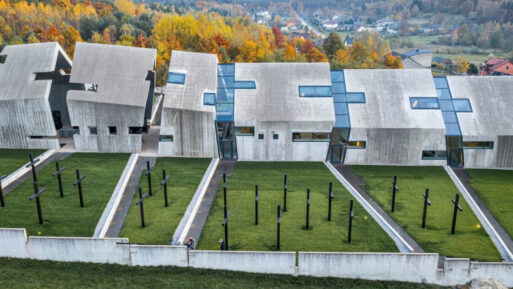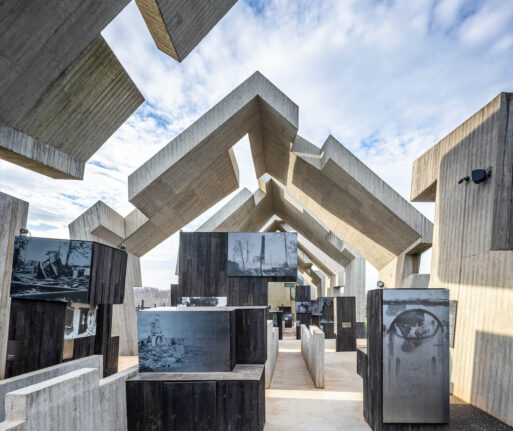
An exterior view of the Mausoleum
Credit: Marcin Czechowicz
Over the course of World War II, Nazi forces committed innumerable atrocities upon the people of Poland. In addition to the violence of the extermination campaigns, German forces waged a war of terror against the Polish civilian populations living in small towns and villages, hoping to discourage citizens from joining the resistance movement. The Mausoleum of the Martyrdom of Polish Villages in Michniów is a monument and permanent exhibit honoring the innocent people who lost their lives during this “pacification” campaign.
A Brief History of Polish Pacification Actions
In German-occupied Poland, the Nazis waged a war of aggression against the civilian population in a “pacification” campaign, designed to prevent and suppress the burgeoning Polish resistance movement that was particularly horrific when perpetrated against the small towns and villages surrounding major cities.
Historians contend that the number of Polish settlements targeted in these pacification measures is approximately 825, and led to hundreds of thousands of people losing their lives to acts of extreme brutality. In one horrific example, on March 8, 1944, over 90 inhabitants of Jablonia-Dobek were herded into a barn doused with gasoline, and grenades were thrown inside.
The Michniów Massacre
On July 12, 1943, residents of Michniów were massacred by German forces, most likely because they were known to actively cooperate with the Polish resistance. It is reported that 102 inhabitants of the town were murdered, many of them burned alive while trapped within their own barns. In retaliation, soldiers belonging to the Polish resistance movement attacked a train that night, killing or injuring about a dozen Nazi soldiers. The next day, German forces returned to Michniów and razed the village to the ground. In total, 204 people were killed, including 54 women and 48 children, many of whom were less than 10 years old. The youngest victim was a nine-day old infant girl, who was thrown into a burning barn by a German military policeman, according to the Muzeum WSI Kieleckiej.
The Mausoleum’s Origins

An overhead view of the degraded, sculptural aspects of the Mausoleum monument
Credit: Marcin Czechowicz
After the war, Michniów became a symbol of the martyrdom of the many Polish villages lost to pacification campaigns. Initially, a red sandstone monument was erected on the mass grave of Michniów’s victims after the end of the occupation. Later, in 1979, an initiative was put forth to establish a nationwide Mausoleum of Martyrdom of Polish Villages, and Michniów was selected as the proposed location. Over 10 years numerous committees and councils deliberated the plans for the monument, and the cornerstone of the mausoleum was finally laid in November 1989.
Unfortunately, the following decade introduced political and economic changes – and ensuing financial issues – that further delayed and modified the project. Finally, in 2008, the Kielce Countryside Museum (an investor in the project) held a competition for design ideas. The team led by Miroslaw Nizio, the founder of Nizio Design International, won first prize and the first stage of expansion of the mausoleum began. On July 12, 2021 the current Mausoleum and exhibition was officially opened, on the 78th anniversary of the massacre, the Day of Struggle and Martyrdom of Polish Villages.
Architectural Aspects of the Monument

The interior of one of the “degraded” segments, showing photographs of the destruction of Michniów
Credit: Marcin Czechowicz
The monument is built to resemble a series of country cottages, arranged one behind another in a single row. The first building, the House of Tranquility, is fully intact and houses a permanent exhibit of artifacts, including narrations of the effects of pacification by the victims and perpetrators of the campaign. Within the exhibit are concrete podia displaying photos and historical documents, along with wood and blackened steel from the old huts and barns brought in from surrounding villages.
But as you proceed from one “cottage” segment to the next, they become more degraded, as if destroyed by a fire. Of the 11 segments, the first five are closed, but as you proceed further they become more sculptural. These degraded segments are progressively open to nature and exposed to the elements, to symbolize the defenselessness of the Polish people. Nizio was inspired by the contrast between the photographs of pre-war Michniów, and the photos of the violence during pacification campaigns:
“Viewing historical photographs of the pre-war village of Michniów with its cottages, its inhabitants, scenes from everyday life, we felt that we were interacting with something full, complete, with the natural rhythm of life. In turn, when looking at the photographs of the pacification of 1943, seeing human drama, death, burning houses, we touched upon painful history, experienced the emotions that accompany the violent breaking of the lifeline. We felt this pervasive and growing destruction. This process served as the impetus for the design of the exterior and the exhibition.”
The mausoleum is a study of opposites that melds effortlessly into a hauntingly memorable experience. The juxtaposition of the blocky concrete forms and organic scorched wood work together to create positive and negative spaces, all the more effective in stark contrast to the natural beauty surrounding the buildings.

 “The Mausoleum of the Martyrdom of Polish Villages in Michniów” by Miroslaw Nizio
“The Mausoleum of the Martyrdom of Polish Villages in Michniów” by Miroslaw Nizio


 Debating Medical Aid in Dying
Debating Medical Aid in Dying
 “Help Me, Helen”
“Help Me, Helen”















